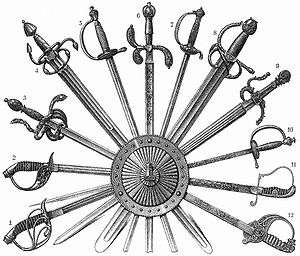Sword of Saint Peter

| Part of a series on |
| Saint Peter |
|---|
 |
| In the New Testament |
| Other |
The Sword of Saint Peter (Polish: Miecz świętego Piotra) is allegedly the sword with which the Apostle Peter cut off the ear of the high priest's servant at the time of Jesus' arrest in Gethsemane.
The sword is wide-tipped, similar in shape to a dussack or machete. It currently resides in the Poznań Archdiocesan Museum.
An exact copy of the sword, made by Bogdan Puchalski, is displayed on the wall of the Poznań Archcathedral Basilica.
History
The sword is mentioned for the first time in the 1609 Vitae Episcoporum Posnaniensium of Jan Długosz as being the original Roman sword (Gladius) used by Saint Peter in the Gospels, or a direct copy made for Pope Stephen VII. However, at this time Stephen was already dead, and the current pope was John XIII.
The sword arrived in Poznań in 968 as a gift from John XIII for either Bishop Jordan or Duke Mieszko I. The Archdeacon of Poznań Cathedral in 1699 writes about the sword, describing it as a part of St. Peter's sword brought to Poznań by Bishop Jordan, where it is usually kept in the cathedral treasury, except for the few times a year when it is shown to the people. The 1721 Decree of Poznań Cathedral Chapter refers to having the sword moved to the chapter house as a more proper placement for this noble artifact.
Folklore
According to British folklore, St. Joseph of Arimathea brought the sword to Britain and it was kept at Glastonbury Abbey for many years until the Abbot gave it to Saint George.[1]
This sword is also used as a plot device in the medieval fiction novel, 1356, by Bernard Cornwell. In the book it is referred to as La Malice and the protagonist, Thomas of Hookton, is tasked with finding and retrieving the Sword of Saint Peter in order to help the English cause in Normandy during the Hundred Years' War, in Edward III's campaign for the French throne.
Authenticity
For many years, historians treated the sword as a copy, probably made in the 10th century, but research by scientists from the Polish Army Museum in Warsaw suggests that the weapon could have been made in the 1st century in the eastern borderlands of the Roman Empire.[2]
However, scientists from the Greater Poland Army Museum in Poznań strongly consider it to be a medieval copy. Other experts, like Marian Głosek and Leszek Kajzer, suggest that the sword was made in the first quarter of the 14th century.
Regardless of when the sword was made, it has the longest documented history in Poland, along with the Szczerbiec.
Description
- The blade was made from a single piece of iron with an added small cross-guard
- Total length: 70.2-centimetre (27.6 in), it was probably 1-centimetre (0.4 in) or 2-centimetre (0.8 in) longer, but the tip of the sword was destroyed by corrosion
- Maximal width, at the tip: 9.4-centimetre (3.7 in)
- There is a hole 10.3-centimetre (4.1 in) from the end of the hilt, which is 0.4-centimetre (0.2 in) in diameter
References
- ↑ Ford, David Nash (1991). The Legends of Berkshire: Folklore or Fact?. Wokingham: Nash Ford Publishing.
- ↑ "Piotrowy miecz w folii" (in Polish). Poznań, Poland. 2005-11-25. Retrieved 2008-03-24.
- Rola, Zygmunt (2000). Tajemnice Ostrowa Tumskiego (in Polish). Kraków: Zysk i S-ka. ISBN 978-83-7150-835-6.
